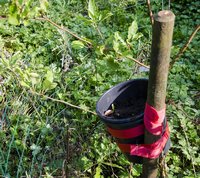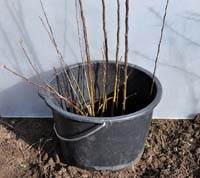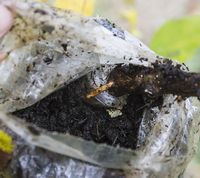Own-root apple trees |
Apple trees from seeds are characterized by growing on own root. To keep a known apple variety, most apple trees produced world-wide are propagated on rootstock.
But apple trees and other fruit trees can also be propagated as own-root trees.
There are several methods to propagate apple trees on own root, some of which I will describe below.
|
| |
|
|
1. Instead of propagating by down bending branches, which often is impossible by apple trees, you can do as shown in the picture. A 1-year old tree are planted in the spring, so it lies across the ground. As the new branches grow up, they are earthed up. Roots will form on the part of the branch that’s underground, and the new trees on own root can be harvested next spring.
|
|
| |
|
2.
Graft a tree with the union close to the root. Use a weak rootstock, and when the tree are ready, plant it with the graft union below the level off the soil.
The scion should then root and take over, and the weaker rootstock will die.
|
|
|
|
3. Graft as above. Remove the bottom of a pot, and use it for earth up the scion, to get the union under soil. When the tree got it's own root, You can cut away the rootstock and plant the tree. That way You can use any rootstock. |
|
|
|
Air layering or Chinese layering on apple |
| Air layering are a useful manner to propagate own-root apple trees. Below I show ways to do it. |
A Chinese layering is a propagation method in which a branch is rooted while the branch is still sitting on the tree.
The plant hormone auxin is important for root formation. Auxin is produced at the growth point of the outermost bud, it is directed downward with the flow of juice in the Cambium. The Cambium are the innermost layer of the bark.
It is important to find a top shoot on the branch you want roots on, as this is where auxin is formed. |
| |
 |
You need to preserve the top shoot of the branches you need to set roots, as this is where the root-forming hormone auxin is developed. |
| |
There are 2 ways to get a branch to root. |
Method 1 |
| 4 - 5 cm bark is removed from the branch. Clear plastic bag with potting soil is placed around the branch where the bark is removed. The auxin, on its way down the cambium, stops at the edge of the bark and causes the tree to form roots. After 8 - 10 weeks, you should see roots through the plastic. The new tree can now be cut and planted in a pot. |
Method 2 |
The bark is not damaged. It is covered in order to avoid the light where roots are to be formed as the plant hormone cytokinin occurs and acts where the tree gets light. Where auxin dominates, roots can be formed.
You can place a pot with potting soil where you want the roots to develop, or, a plastic bag with potting soil is placed and laced where you want the roots to develop. It is covered with staniol or black plastic. It can take up to 12 months before roots are formed.
Chinese layering (air layering) has in the past been used to make ovn - root fruit trees. The method has probably also been used in the past by people who have not mastered the art of grafting. |
| |
Method 1 - Air layering with bark removed |
|
On a branch, on a pencil's thickness or thicker, the bark of 4 - 5 cm is removed. Auxin can't get any further down than to the top edge. |
|
|
|
A plastic bag is pulled over. The plastic bag is tied together around the branch a distance below where the bark is removed. |
|
|
|
It is filled with potting material in the bag, which is again tied tightly around the branch a little above where the bark is removed. |
|
|
After 8 - 10 weeks roots can be seen through the plastic bag. |
|
|
|
Roots are formed after 8 - 10 weeks.
The tree can be cut under the roots and planted.
|
|
|
Method 2 - in pot |
|
 |
2 flower pots are cut with an angle grinder as shown in the photo. |
| |
|
 |
When the pots are put together, there will be a hole, where a branch of the apple tree can get through. |
| |
|
 |
Here are the two pots set on a pole by a small apple tree. One branch is passed through the hole and protrudes above the pot and potting mix are filled in the pot. |
| |
|
 |
A air layering established in April, has developed roots late october same year. |
| |
|
| |
|
Experience has shown, that it is necessary to place a plastic bag around the foil to hold it in place under windy conditions. |
|
| |
|
In the middle of October a tiny root are seen on the branch. When the leaves have fallen from the tree in November, I will cut off the branch and plant it. |
|
| |
|
An air layering with lots off roots. |
|
| |
Based on my current experience, the recipe will be:
Method 1. The air layering are made in may - june. when trees are in growths.
Method 2. The air layering are made late March or early April. |
| |
Propagation of rootstocks with cuttings |
With black plastic for planting bag, You kan prepare cutting so they can root in the late autumn.
In springtime, wrap black plastic around the branch. Darkness causes the root hormone auxin to be dominating. Stick the cuttings in soil in November. there is a good change roots will form during winter.
|
 |
 |
 |
Plastic wrapped 12-06-2019 |
Roots formed 02-01-2020 |
|
|
Propagating rootstocks with soil. |
 |
When You have own-root apple trees, You can propagate new own-root apple trees the same way as propagating rootstocks. |
|
| |
|
|
|
|























